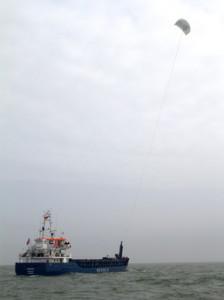 Some green tech companies are based on complicated concepts, (KiOR the producer of biofuels from non-food stuff comes to mind), and others, like the one I will look at this week employ a more straightforward, simple premise. This week I will be looking at SkySails, a privately held company, which, as its name suggests, manufactures kites–very large kites–that are used to save fuel costs for ships and other ocean-going crafts while also being environmentally friendly.
Some green tech companies are based on complicated concepts, (KiOR the producer of biofuels from non-food stuff comes to mind), and others, like the one I will look at this week employ a more straightforward, simple premise. This week I will be looking at SkySails, a privately held company, which, as its name suggests, manufactures kites–very large kites–that are used to save fuel costs for ships and other ocean-going crafts while also being environmentally friendly.
SkySails’ kites take advantage of the strong, high-altitude winds to propel ships and thus reduce the amount of fuel used. The basic SkySails equipment consists of an enormous kite, a control system for the kite, and a launch-and-retraction system. Made of a ultra-light synthetic fibre, the kite has an area of approximately 2,400 square feet (or about the size of a small house). Depending on the size of the kite, the operator lets out the towing rope to between 900 to 1,400 feet away from the ship in favorable wind conditions. The kites usually fly at an altitude of between 500 – 650 feet, typically in a ‘figure eight’ pattern covering a width of 800 feet and height of 160 feet. Because the kites fly in uncontrolled airspace, they are brightly colored so as to increase their visibility. Their size also makes them hard to miss. At night the kites are lit up to ensure they can be clearly seen. The SkySails’ performance control system, installed on board the ship, calculates performance and maximizes the kite’s efficiency–and thus fuel savings–for the ship.
Estimates suggest that a ship equipped with SkySails will consume from 10 to 35% less fuel than a conventionally-powered vessel. For the average size ship, the savings can range from one to three tons of oil a day or approximately $2,000 a day. Per SkySails’ calculations, the kites can be used 20 – 40% of the time at sea, resulting in average annual savings of approximately $150,000 to $200,000 per ship per year (compare this to the reported $250,000 system cost). Future plans include a 17,000 square foot sail for large cargo ships which will result in an approximately 50% reduction in fuel costs.
Several ships have used SkySails’ technology. The first commercial ship to do so was the MS Beluga Skysail, a container cargo ship, which deployed a 1,700 square foot kite. The ship completed its maiden voyage in the first quarter of 2008, sailing from Germany to Venezuela, then to the United States before arriving in Norway. Using the kite resulted in an estimated 10-15% reduction in fuel use and a savings of $1,000 to $1,500 per day. In 2010, SkySails announced Germany’s largest fishing ship, the Maartje Theadora, would be the first fishing trawler to employ the technology. More recently, Cargill has signed an agreement with Greek ship owner/manager Anbros Maritime S.A. to install the world’s largest kite, a 3,400 square foot one, on its Aghia Marina dry bulk cargo vessel.
Perhaps the biggest challenge facing SkySails is the impact of the current global economic downturn. The levels of cargo transported around the world have dropped off precipitously making shipowners unwilling to invest the necessary funds for alternative propulsion systems. Once the global economy improves, the prospects for SkySails should as well.
Source: SkySails
Disclaimer: This article is intended to be informative and should not be construed as personalized investment personalized advice. You are responsible for your own investment decisions.
Disclosure: The author does not have a position in SkySails.

